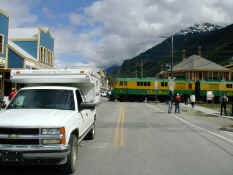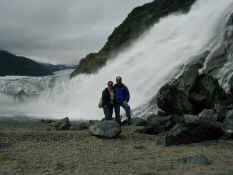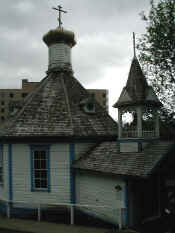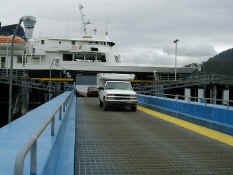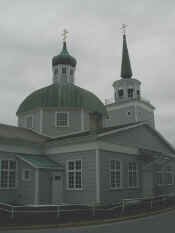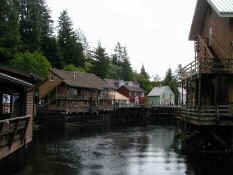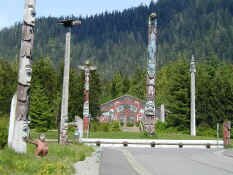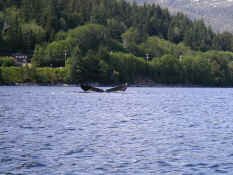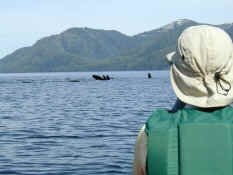June 5
June 6
June 7
June 8
June 9
June 10
June 11
Last night we spoke to the people who were camped next to us and found that they are doing a re-creation of a miner's hike over the Chilkoot Pass and all the way to Dawson City. They are doing it in period clothing and carrying the types of equipment the miner's were required to have with them, plus some things that they might have wanted to take but I'm sure would later prove to be impractical and impossible to carry; things like steamer trunks and phonographs! They are under contract to finish what they start, but after hiking just the few couple of miles we did, I can't imagine having the determination to finish the whole thing under those old conditions.
Since we would be catching the ferry to Juneau later in the day, we spent our morning walking around the old town of Skagway. In 1897 the population of Skagway was 10, two years later it was 20,000 and the gold rush city was the largest town in Alaska and infamous for its lawlessness. "Soapy" Smith and his gang of thugs ran the town and swindled newcomers and old-timers alike. He was finally killed along with city engineer Frank Reid in a shoot-out. That ended his reign and his gang was run out of town.
|
The town is also the starting point for the White Pass & Yukon Railroad. Construction on it was started in 1898 and the line was cut through solid rock with nothing more than picks, blasting powder and shovels. It was completed in 1900 and ran from Skagway over White Pass (also known as Dead Horse Trail) and up to Lake Bennett. It provided an alternative to miners who didn't want to climb over the Chilkoot or White passes. Today it carries tourists through some of the most spectacular scenery in the state. |
Later in the day it was time to catch the ferry. We had to line up with all the vehicles to be put aboard and wait our turn. Eventually we were directed into the bowels of the ship and told to take whatever we needed for the next seven hours and we wouldn't be allowed access to the truck once underway. Back up top we found a nice spot on the observation deck and spent the next seven hours looking out at gorgeous scenery and watching for whales. We didn't see any whales but we did see some dolphins and birds.
Our ferry arrived in Juneau about 11:00 pm last night, so the only thing we were interested in doing was getting camp set up and going to sleep. Funny thing, as we head south we are getting into nighttime darkness again. Still, it doesn't get dark until later than we are used to in Arizona.
| After leaving the glacier, we drove 13 miles to downtown Juneau. The city center is a historical district with many buildings dating back to the early 1900s. When we were there, 5 cruise ships were docked and the city looked like it was under siege by mobs of visitors from the ships. We walked around exploring the buildings and made our way up the hill to St. Nicholas Russian Orthodox Church. The church is octagonally shaped and it was built in 1894. The funny thing about the church is that it was not built for the Russians as none lived in Juneau. It was built for the Tlingits who had converted to Christianity. |
Juneau has an interesting history too. Turns out that the first gold strike in Alaska occurred here in 1880. After gold was discovered, the town was set up, making it the first town to be founded after Alaska's purchase from the Russians. It became the capital of Alaska in 1906 when the capital was moved from Sitka. The gold was so plentiful in Juneau that by World War II, about 25 percent of all the gold then produced in Alaska had come from just a single mine, the A-J Mine, in Juneau.
Our schedule for the next week will be dictated by the ferry schedules. Today for instance, we had to get in line at the dock by 6 pm.
We decided to start our day by doing errands and finding a laundromat. We then went down to the Mendenhall Wetlands and Refuge where we had lunch and searched in vain for wildlife. Last night we spotted nearly a dozen bold eagles here - today they're all gone.
After lunch we went back to the Mendenhall Glacier to do another hike. When we looked out at the glacier we saw that sometime in the last 24 hours a huge iceberg had calved off the face. The break allowed us to look into the deep blue heart of the glacier - very cool!
On our way to the ferry port, we stopped at one of the many beaches around Juneau to look for marine animals. We didn't have to look long before we saw large fish jumping, dolphins playing and 2 humpback whales swimming.
Then it was time to leave. We drove onto the ferry, the M.V. Le Conte, then found ourselves a spot in the solarium on the upper deck to set out our sleeping bags. By the time we wake we'll be more than 1/2 way to Sitka.
The morning ferry ride was a lot of fun. The sea was really calm and that made it easy to spot animals. We could see a couple of spouts so we knew whales were nearby, but we couldn't see much else of them. Our route took us through the very narrow Peril Strait. The strait was so narrow that at times shore was only a stones throw away. At those times the captain had a crew member stationed up front to look for shoals and rocks. If they saw any, the crew member would quickly drop anchor and tell the captain to stop the boat. As exciting as that would be, we fortunately didn't have to stop.
Along the way we saw several sea otters floating on their backs, probably enjoying a tasty snack. We saw more bald eagles and a few seals. The bald eagles are very common in this area, but that doesn't make the sight of them any less exciting. They are truly magnificent birds.
Although we're spending the night in Sitka, we really only had a few hours to explore before buildings and parks closed. Sitka has a long history and we wanted to view as much of what remains as possible. Sitka was the capital of Russian America during the early 1800's when the Russians hunted and trapped along the Alaskan coast. When the fortunes of the fur trade declined, the Russians sold Alaska to the United States - even though the First Nations argue that the Russians didn't own the land. When the USA took over Alaska, the ceremony for the transfer took place in Sitka. The United States also used Sitka as their main outpost for nearly 20 years.
We drove into the downtown and stopped at the main square, known as Totem Square, were we could see the history of the area in miniature. In front of us was an old Russian cannon, 3 old anchors belonging to 19th Century ships from the US or England and an old Tlingit totem pole. Behind us stood the Alaska Pioneers Home for elderly Alaskans from the gold rush and homesteading days, and on the hills on either side stood a (reconstructed) Russian block house - like the ones used to defend the Russian fort, and the hilltop where the Russians ruled from - Castle Hill.
| Walking down the street we passed several buildings that were built by the Russians. We also stopped by St. Michael's Cathedral. Built in 1844-48 the church was considered the finest Russian Orthodox Church in Alaska. It burned to the ground in 1966, but the locals rescued all the treasures and icons and rebuilt a replica of the church. It still looked impressive, but the doors were locked so we could not view the rescued treasures. |
We had two other important places that we still wanted to explore. The Sheldon Jackson museum (the SJ) and the Sitka National Historical Park. The SJ contains the oldest collection of indigenous objects in the state. The collection is just amazing. We viewed old masks, hunting tools, baskets and boxes, clothing, boats, sleds and more. I was fascinated to see the boxes as they were made from a single piece of wood bent around and stitched together to form the sides. The bottom was also sewn on. It was impressive to see the different types of clothing made from the local animals and used for warmth or waterproofing by the native people.
Our last stop, the Sitka National Historical Park contained 15 totem poles that were removed from abandoned native villages in the late 1800s. There are also a couple of reproductions that are just stunning. All the totems were made either by Tlingit or Haida clans. The park is also the location of the battle in 1804 between the Russians and the Tlingits for control of Sitka. The Tlingits had beaten the Russians in 1802 and expelled them from the area. In 1804, the Tlingits ran out of ammunition and had to withdraw, giving the land to the Russians.
We ended the day with a splurge at a nice restaurant with a great view looking across the bay toward Mt. Edgecumbe, an extinct volcano that looks like Japan's Mt. Fuji. Tomorrow we spend the entire day and night on another ferry to our final Alaska destination, Ketchikan.
Today was just a lazy day on board the SS Taku as we made our way across the straits and through the narrows of the Inside Passage. While we sat and read, we made sure to take every opportunity to scan the water in search of dolphins, porpoises, whales and seals. Several times during the day we spotted the sea mammals. Our best spot was of a large group of humpback whales off in the distance. Through the binoculars we could see them breaching (jumping out of the water) and crashing back with large splashes.
We arrived in Ketchikan at noon today and drove into downtown to explore. To our delight there was only one cruise ship docked so the streets would not be packed solid with people. We grabbed our camera and headed off for our own walking tour of town.
Ketchikan is built at the foot of hills that fall right into the sea. The early residents realized that the town would be short of flat land to build on, so they constructed many building on pilings and built their roads on trestles (long bridges) seemingly suspended from the hillsides. These roads are actually made from wood planking and reminded us of being on pier.
|
One area of town is built over Ketchikan Creek. All the buildings are on pilings driven into the creek bed. This area was the red light district of early Ketchikan, and the raised boardwalk is named "Married Mans' Street". During prohibition, these buildings were the taverns and speakeasies where people would go for bootlegged alcohol. The businesses had trap doors in their floors so that they could hide their delivery of their shipments and if the police came the alcohol could be dropped out through the floor. While we were standing on a walkway over the creek, we saw a seal swim up in search of spawning salmon. |
We followed the creek and passed a fish ladder that was built to help the salmon bypass a waterfall. The creek is a spawning ground for salmon that were released from a hatchery just upstream. The hatchery is run by Tlingits and more than 350,000 salmon and trout are raised and released annually. One of the really cool things at the hatchery is that they care for injured bald eagles. When we visited, there were two of these magnificent birds there. Mature bald eagles can have a wingspan of 6 to 8 feet! We also had the opportunity to feed some of the young fish being raised there. As we threw handfuls of food into the tanks, the water erupted with fish flinging themselves out of the water in their pursuit of food.
| After walking around for several hours, we drove just south of town to the Tlingit village of Saxman. Here there is a tribal park where the clan has moved 24 Totem poles from abandoned native villages to preserve them. Many poles have beaver carvings as this clan is the Beaver Clan. There is also a reproduction of the totem pole carved with a likeness of Abraham Lincoln at the top. |
Our last full day in Alaska turned out to be magnificent. A bright blue sky and not too much breeze. We had decided the day before (when it was windy and cold) that we wanted to spend our last day sea kayaking. We signed up with the knowledge that a high pressure system bringing better weather was on its way, so we kept our fingers crossed.
With a blue sky dawning we headed off to meet our kayak guide. As it turned out, he was running a little late, so we had an hour to kill. We drove down the coast and stopped at a turnout to look at the view. Not five seconds had gone by when into my binocular view came...Orca fins! Two of them...three of them...four, five! Five Orcas, killer whales, swimming down the coast and playing! We even got to see one of them breach (jump out of the water) twice!
We watched them for about ten minutes and as they went out of view down the coast, we started up the car to look for another turnout. Some other people who had been watching followed us out and we drove about a mile before finding another place to stop. Other cars began to stop as people realized what was happening right off shore. And what a stop it was. The coastline jutted out at this spot and as the whales came down the coast they just kept coming closer and closer to shore until right where we were standing, they passed within twenty feet. We were also above them and got an absolutely incredible, once-in-a-lifetime view as they swam by.
These animals are graceful and strikingly beautiful with their black and white coloring. They also have a huge pectoral fin that on the largest male, stood 7 feet high. This male's pectoral fin was also "crinkled" making it very distinctive. They were swimming pretty fast, but they were also taking time to do some rolls and a couple of times they lay on their backs and slapped their huge tails on the water. The sound was like a gunshot!
After following them to a couple of more turnouts, we knew we had to meet our kayak guide (now we were the late ones!) Arriving at the put-in, we apologized for keeping him waiting, but when we explained what we had been doing, he got very excited. This was a chance to see whales from the water!
Hurriedly getting our kayaks in the water, we took off up the coast. After paddling along the gorgeous coastline for a couple of miles, we could see spouts up ahead. But the spouts seemed awfully large, hmm. After paddling for a few more minutes, Greg, our guide, realized that these weren't Orca spouts, they were humpback whale spouts! A mama and her calf. Unable to catch up to them as they crossed the channel, we continued north to find the Orcas.
After paddling for a total of about 6.5 miles, we decided it was lunch time and time to turn around and lazily drift back with the current. But no sooner had we pulled out our sandwiches, than a family along the shore pulled up in their car and shouted to us that there were humpbacks coming! Quickly putting our lunches back away, we starting scanning the horizon for spouts. Two minutes later, the humpbacks surfaced right in front of us! They had circled around and come back across the channel. We followed them south down the coast making sure to keep a safe distance.
| As they entered an area called Herring Cove, they suddenly dove deep. After looking for them for a few minutes, we noticed a large ring of bubbles rising to the surface of the water just in front of us. Within seconds, the mama whale came shooting up through the center of the bubble ring arching through the air with her mouth wide open! Slapping back down to the surface, she rested for a few moments before showing us her tail and once again diving deep. |
We realized immediately what was happening. Humpback whales use a technique called "bubble nets" to fish for the herring that they eat. When they find a school of fish, they dive deep and start blowing bubbles. The bubbles trap the fish within this "bubble net" and the whale shoots upward through the trapped school with its mouth wide open. In this manner the whale is able to scoop up a huge mouthful. Her rush through the water only ends when she hits the surface.
The whales continued to feed in this manner for about twenty minutes. Sometimes separately and sometimes in tandem the whales would rise out of water and slam back down in an amazing show. We had to be careful to stay out of their ring of bubbles however! Even though they knew we were there, when they are hurtling after food, we're not really foremost on their mind!
| After not seeing the whales for a few minutes, Greg began looking back out into the channel and spotted...Orcas! After being totally amazed by the humpback show, now we had Orcas coming across the channel! We paddled out a little ways and sat. And sure enough, those Orcas surfaced right in front of us. Swimming and playing, it was the same pod that we had seen earlier. Greg explained that this is a resident pod and the large male with the crinkled pectoral fin is the patriarch. He also explained that this pod did not eat mammals, they only ate salmon. We watched them for several minutes as they continued back up the coast and then turned back inland. |
Paddling back into Herring Cove, we discovered that the humpbacks had moved on. But in their place, we began to see King salmon jumping out of the water. When the salmon return to their birthing grounds readying themselves for spawning, they gather at the mouths of the rivers. Crowded together, they begin leaping out of the water and this was what we were witnessing. The power of these fish was amazing. They were at least three feet long but they were able to propel themselves two feet out of the water. It was incredible.
Because of the amount of fish amassed in one place, fishermen of all kinds also massed. Including fishermen of the seal variety. There were at least six seals gathered at the mouth of the river. We were even witness to a seal stealing a fish off the line of a human fisherman. And then there were the eagles, just waiting for the tide to go down and for it to be their turn.
After this incredible show, it was time to return. We had spent six hours reveling in the magnificent display of nature that Alaska has to offer. It was the perfect ending to our Alaska and Yukon Adventure.
Tomorrow we board our last ferry, one that will take us back to Bellingham, Washington just north of Seattle where the steamship SS Portland arrived in July 1897 carrying "a ton of gold" setting off the Klondike Gold Rush. Once we arrive in Bellingham, this expedition will come to a close. Thanks for joining us in the Yukon and Alaska.
